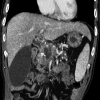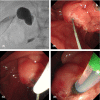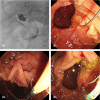Successful biliary cannulation by the rendezvous technique via percutaneous transhepatic gallbladder drainage: A report of two cases
- PMID: 30564324
- PMCID: PMC6293181
- DOI: 10.1002/ccr3.1836
Successful biliary cannulation by the rendezvous technique via percutaneous transhepatic gallbladder drainage: A report of two cases
Abstract
Reports of the rendezvous technique via percutaneous transhepatic gallbladder drainage are very rare because of difficulties with insertion of the guidewire from the gallbladder into the common bile duct. In particular, our report includes a case with distal common bile duct stricture. To our knowledge, such a case has never been previously reported.
Keywords: biliary cannulation; distal common bile duct stricture; endoscopic retrograde cholangiopancreatography; percutaneous transhepatic gallbladder drainage; rendezvous technique.
Figures




Similar articles
-
The rendezvous technique involving insertion of a guidewire in a percutaneous transhepatic gallbladder drainage tube for biliary access in a case of difficult biliary cannulation.J Rural Med. 2017 May;12(1):46-49. doi: 10.2185/jrm.2918. Epub 2017 May 24. J Rural Med. 2017. PMID: 28593017 Free PMC article.
-
Modified rendezvous intrahepatic bile duct cannulation technique to pass a PTBD catheter in ERCP.World J Gastroenterol. 2010 Nov 14;16(42):5388-90. doi: 10.3748/wjg.v16.i42.5388. World J Gastroenterol. 2010. PMID: 21072905 Free PMC article.
-
Interesting rendezvous location in a liver transplantation patient with anastomosis stricture.World J Gastroenterol. 2014 Nov 14;20(42):15916-9. doi: 10.3748/wjg.v20.i42.15916. World J Gastroenterol. 2014. PMID: 25400478 Free PMC article.
-
Endoscopic salvage therapy after failed biliary cannulation using advanced techniques: A concise review.World J Gastroenterol. 2022 Aug 7;28(29):3803-3813. doi: 10.3748/wjg.v28.i29.3803. World J Gastroenterol. 2022. PMID: 36157537 Free PMC article. Review.
-
Endoscopic ultrasonographic access and drainage of the common bile duct.Gastrointest Endosc Clin N Am. 2013 Apr;23(2):435-52. doi: 10.1016/j.giec.2012.12.013. Epub 2013 Jan 30. Gastrointest Endosc Clin N Am. 2013. PMID: 23540968 Review.
Cited by
-
Gallbladder: Role of Interventional Radiology.Semin Intervent Radiol. 2021 Aug;38(3):330-339. doi: 10.1055/s-0041-1731371. Epub 2021 Aug 10. Semin Intervent Radiol. 2021. PMID: 34393343 Free PMC article. Review.
References
-
- Larkin CJ, Huibregtse K. Precut sphincterotomy: indications, pitfalls, and complications. Curr Gastroenterol Rep. 2001;3(2):147‐153. - PubMed
-
- Cote GA, Ansstas M, Pawa R, et al. Difficult biliary cannulation: use of physician‐controlled wire‐guided cannulation over a pancreatic duct stent to reduce the rate of precut sphincterotomy (with video). Gastrointest Endosc. 2010;71(2):275‐279. - PubMed
-
- Calvo MM, Bujanda L, Heras I, et al. The rendezvous technique for the treatment of choledocholithiasis. Gastrointest Endosc. 2001;54(4):511‐513. - PubMed
-
- Freeman ML, Guda NM. ERCP cannulation: a review of reported techniques. Gastrointest Endosc. 2005;61(1):112‐125. - PubMed
Publication types
LinkOut - more resources
Full Text Sources

